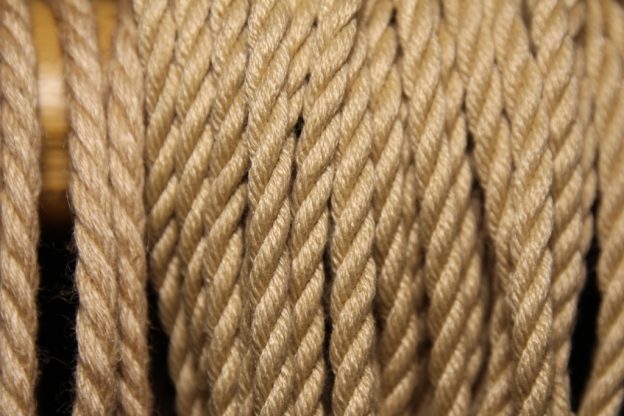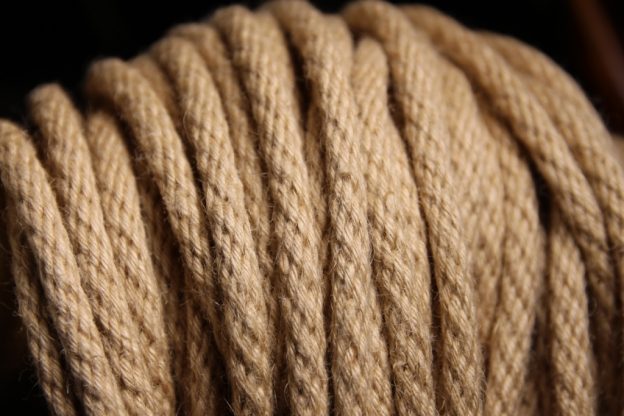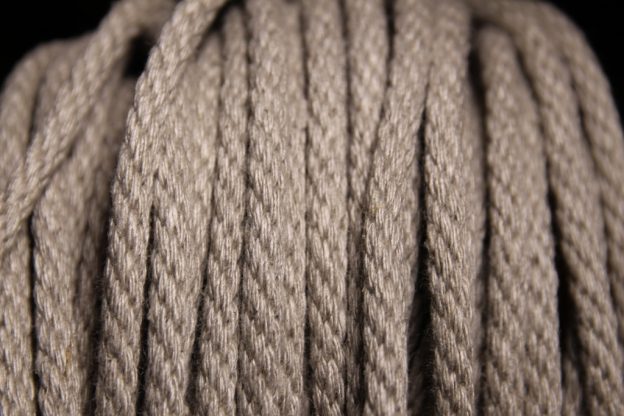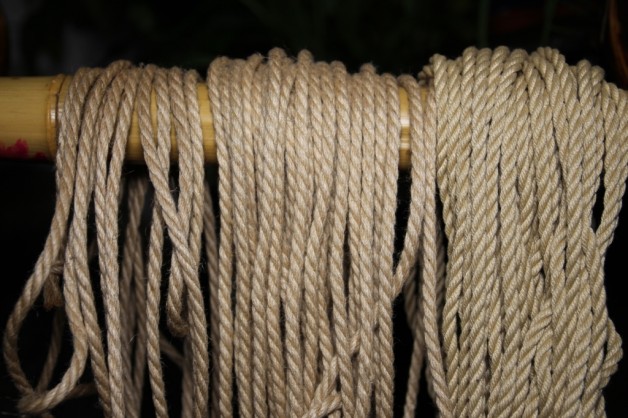Over the past few months, I have been working with a major yarn and rope manufacturer to create the perfect shibari rope. What’s perfection? The highest quality fibre is needed for starters since you can’t make a silk purse from a sow’s ear. This is why I have gone to source and to a supplier who has their own yarn. That way, there is quality control all under one roof at every stage. This should mean excellent consistency of the product. What has impressed me most is that this manufacturer is amazingly pro-active and keen to work to produce exactly what I want. So far, they have done what they said they would and more, the results are outstanding.
Today, I received some very interesting shibari rope samples from them which included:
- Loose laid twisted jute, comprising 3 plies, comprising 3 plies, each containing 7 sub-plies of 5 yarns. 14.1g per metre
- Loose laid twisted polished linen hemp, comprising 3 plies, each containing 7 sub-plies of 5 yarns. 17.9g per metre
- Loose laid twisted unpolished linen hemp, comprising 3 plies, each containing 7 sub-plies of 5 yarns. 18.2g per metre
- Loose laid twisted polyvinyl acetate (PVA), comprising 3 plies, each containing 7 sub-plies of 5 yarns. 15.1g per metre
- Loose laid twisted spun polyester (POSH), comprising 3 plies, each containing 7 sub-plies of 5 yarns. 12.3g per metre
- Braided solid core flax (giving a twisted appearance)
- Braided solid core jute (giving a twisted appearance)
I haven’t really had a chance to play with the rope properly yet but here are my first impressions on unpacking it. As I’d hoped, the fibre is superb without a blemish and no dark or rough bits. There is barely any fuzz on the jute and absolutely nothing to burn off on the flax and linen hemp. Since the yarn used is so fine and there are so many per ply , it is very consistent thus creates no irregularities in the rope due to joins or yarn thickness variations. The lower the yarn count the thicker the yarn has to be and the diameter tends to less precise producing a lumpy rope. That’s why a high yarn count is a desirable quality.
3-ply shibari rope
Today, I’ll talk mainly about the twisted 3-ply samples (see header image for jute variations). There are 5 yarns in each of the 7 sub-plies, so that’s 35 per ply in both the jute and linen hemp. This makes it about 3 times finer than the best Japanese asanawa and much finer than the typical shibari rope. The idea of adding sub-plies, i.e. a further set of bunches twisted to make the 3 main plies, is to produce a smooth yet stable rope.
The problem with loose laid, high yarn count, single yarn rope, e.g. Osaka, is that, whilst it is fantastic to use, it need a lot of TLC to prolong its life. Here I’m referring to jute as I have no experience of any other loose laid sigle yarn rope. My Amanawa linen hemp, whilst having a huge yarn count is relatively hard laid and is extremely durable and stable. This type of construction is typical of the best Japanese ropes. On the other hand, double yarn ropes, e.g. Tossa, tend to be coarser, yet very durable and forgiving of abuse. This new construction is designed to give the best of both worlds, durability and feel. They seem to have achieved this goal. The result is super-flexible soft rope that doesn’t need any wet treatment at all; not even if you are really fussy.
What about the smell, you ask? Big surprise! Neither Nina nor I could notice any JBO (jute batching oil) smell in the jute but maybe we should check with non-smokers? I will ask what process was used as I suspect it could be one of the more eco-friendly methods. As for the linen, flax and synthetics, I’d say new clothes smell and not a trace of hemp’s rank farmyard odour. Personally, if I want to play with associations with smell and rope sessions, I find something like jasmine far nicer but each to their own.

Polished (left) and unpolished (right) linen hemp
The main difference I have noticed between the polished and unpolished linen hemp is the twist of the latter seems a little more defined and the feel is not as smooth. The unpolished seems a little thicker but not as dense as the polished so I guess that accounts for the 1.7g per metre weigh difference. What I love is how similar it felt to the jute (said as a dedicated jute fan). Often hemp has too much friction so tends to drag on pull-throughs, unlike jute which generally feels faster and moves more easily. In this case, the polished rope feels very slick but it’s a very marginal over the unpolished. As somebody used to light ‘flickable’ ropes, rather than the typical heft of hemp variants, I was expecting it to find it comparatively heavy, however it’s very close in weight at only about 10% more than the jute version. I didn’t expect a hemp-type fibre to feel so jute-like. Even Nina, who is more picky about her rope, said “I’d tie with that!”. That’s quite some praise.
Another surprise was the weight and feel of the POSH synthetic jute. I never thought I’d hear myself saying I was really looking forward to tying with a synthetic but in this case I am. It’s the lightest and more pliable rope I have handled for its diameter. On first sight, it looked thicker and tighter laid than I’d like but it seems that a bit of tension changes that. This is one of those cases where it is incredibly hard to give an accurate measurement. Relaxed, it is around 7mm but under tension it is the specified 5.5mm. It reminds me of rope that has been wet treated and not dried under tension. I’m hoping this initial springiness will will disappear with use. I’ll let you know how it is once it has had a bit of use and stretching.

6mm POSH synthetic jute rope
To handle and to look at, you could be forgiven for thinking the POSH is super-light jute with a slight sheen, not a synthetic. The only thing that might make you suspect it isn’t the real thing is the smell and fact that it is just too perfect to be natural…a little like breast implants, really 😉 A massive bonus is the strength which must be near on 500kg (1,200lb) from my knowledge of this type of fibre but I need to check. If tests bear out my initial impressions, a lot of die-hard natural fibre fans might be changing allegiance. Could this be like old-school photographers saying “Pft! Digital!? No serious photographer would ever use on of those cameras!” ? No treatment, no maintenance, no yarns joins, no imperfections and rated to meet the 10x safety factor. If it turns out to be affordable and the rope settles down to 5.5mm, what’s not to like?
I’m reserving judgement on the PVA rope till I play with it some more. Compared to the other samples, it seems to feel a little crisp and slightly stiffer but it is almost indistinguishable visibly from the natural jute. When I say ‘stiffer’, this is relative to the other very soft samples. It is still a lot softer and more flexible than many wet treated ropes.
Braided shibari rope
I’ll cover the braided ropes later as that’s a whole subject on its own. Whilst there’s nothing new about braided shibari rope, what is very different is the way the manufacturers have developed a braid which mimics a twisted rope. I have to say that braided rope is a bit outside my area of experience as I have rarely tied with it and then only with the very stretchy cotton/poly cotton varieties. This rope is nothing like the braided bondage rope sold by most adult shops or even Kinoko’s UV cyber-rope. Firstly, it is quite dense, pliable and definitely not stretchy. Like the other ropes in the sample, it is extremely clean and could easily be used without wet treatment. A brief experiment shows that it does in fact leave diagonal rope marks characteristic of a twisted rope. New territory indeed. More soon.

Braided 6mm jute rope

Braided 6mm hemp rope

